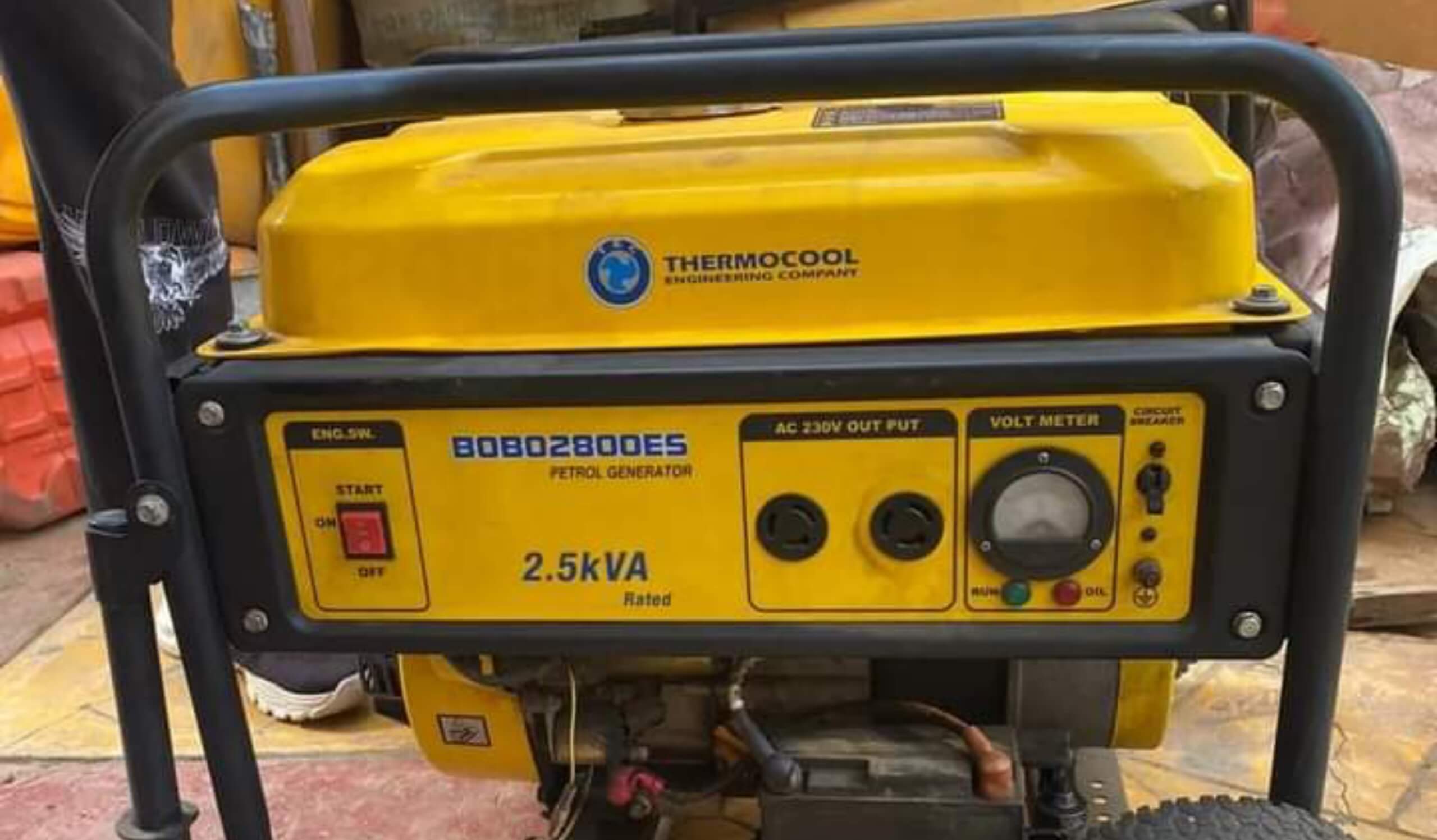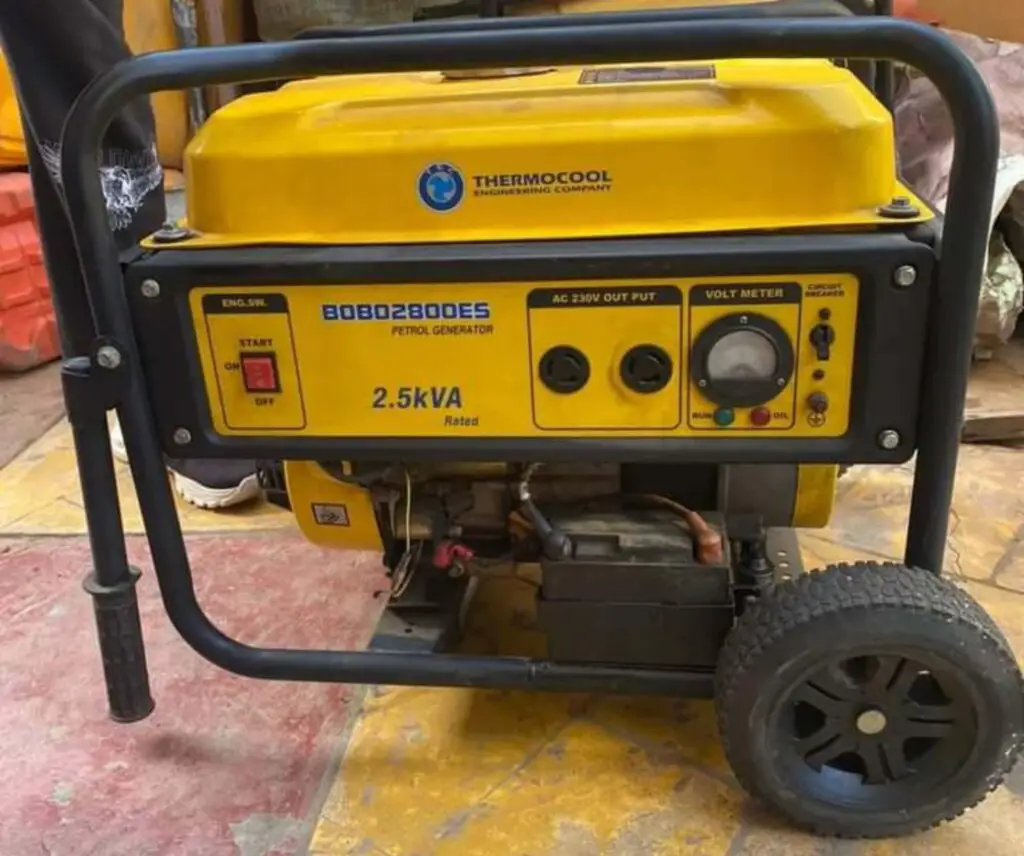As an Amazon Associate, we earn from qualifying purchases. This does not affect the price you pay or the quality of the products you buy. For more information, please read the full affiliate disclosure here.
A 2.5 kVA generator is a small and portable device that can power appliances, such as fans, refrigerators, televisions, phone chargers, etc., and devices in case of a power outage or emergency. It is also known as a 2.5 kW generator or a 2500 W generator.
You can find a 2.5 kVA generator in houses, offices, or commercial centers. These kinds of generators mostly come in gasoline and from different brands, but if you’re planning on buying one and don’t want to get the one that would cost you a lot later, check out our book using this link. The book will guide you through the process of buying an excellent generator for your business, office, or home use.
Without further ado about buying a generator, in this blog post, I will explain what a 2.5 kVA generator is, how it works, what its advantages and disadvantages are, and some of the common appliances that can be powered by it.
What Is a 2.5 KVA Generator?

A 2.5 kVA generator is an electric device that converts mechanical energy into electrical energy by using an engine or a turbine to spin a generator rotor. The generator produces alternating-current (AC) electricity that can be used to power various electrical devices and appliances.
A kVA (kilovolt-ampere) is a unit of apparent power that measures the maximum amount of power that an AC source can deliver to an AC load at any given time. A 2.5 kVA generator has an apparent power rating of 2500 VA or 2500 W.
A kW (kilowatt) is another unit of apparent power that measures the actual amount of power that an AC source delivers to an AC load at any given time. A kW is equal to one thousand watts or one kilowatt-hour of energy per hour.
To convert between kVA and kW, we need to know the voltage and the power factor of the AC source and load. The voltage is the difference in electric potential between two points in an electric circuit, measured in volts (V).
The power factor is the ratio of real power (the actual amount of power delivered by the source) to apparent power (the maximum amount of power delivered by the source), expressed as a decimal number between 0 and 1.
The formula for converting between kVA and kW is:
kW = kVA x voltage x power factor
For example, if we have a 2.5 kVA generator with a voltage of 120 V and a power factor of 0.8, we can calculate its output in kW as follows:
kW = 2500 x 120 x 0.8 kW = 30000
This means that the generator can deliver up to 30000 W, or 30 kW, of real power to its load.
ALSO READ:- FAQs: What Will 8000 Watt Generator Run?
How Does a 2.5 KVA Generator Work?
A typical 2.5 kVA generator consists of three main components: an engine or turbine, a transmission system, and a distribution system.
The engine or turbine is the heart of the generator, which converts mechanical energy into electrical energy by spinning at high speed inside a cylinder or rotor.
The transmission system transfers the rotational motion from the engine or turbine to the distribution system through gears, belts, chains, or shafts.
The distribution system delivers the electrical energy from the transmission system to various electrical devices and appliances through wires, cables, outlets, switches, fuses, breakers, etc.
Some examples of engines or turbines that are commonly used in generators are diesel engines, gas engines, gas turbines, steam turbines, etc.
Some examples of transmission systems that are commonly used in generators are belt drives, chain drives, shaft drives, etc.
Some examples of distribution systems that are commonly used in generators are single-phase circuits, three-phase circuits, parallel circuits, series circuits, etc.
What Are Some Advantages and Disadvantages of Using a 2.5 kVA Generator?
ALSO READ:- FAQs: What Will A 2000 Watt Generator Run?
What Are Some Common Appliances That Can Be Powered by a 2.5 KVA Generator?

A 2.5 kVA generator can power a variety of common appliances that are used in households, offices, shops, campsites, etc. However, the number and type of appliances that can be powered by a 2.5 kVA generator depend on the total power consumption and the starting power of each appliance.
The total power consumption of an appliance is the amount of power that it consumes when it is running, measured in watts (W) or kilowatts (kW). The starting power of an appliance is the amount of power that it consumes when it is turned on, measured in volt-amperes (VA) or kilovolt-amperes (kVA). The starting power is usually higher than the running power, especially for appliances that have motors, compressors, or heating elements.
To calculate the total power consumption of a set of appliances, we need to add up the running power of each appliance. To calculate the starting power of a set of appliances, we need to add up the starting power of the appliance with the highest starting power and the running power of the rest of the appliances.
For example, if we have a refrigerator that consumes 200 W of running power and 1200 VA of starting power, a microwave oven that consumes 800 W of running power and 1000 VA of starting power, and a TV that consumes 100 W of running power and 200 VA of starting power, we can calculate the total power consumption and the starting power of the set as follows:
Total power consumption = 200 W + 800 W + 100 W
Total power consumption = 1100 W or 1.1 kW
Starting power = 1200 VA + 800 VA + 100 VA
Starting power = 2100 VA or 2.1 kVA
To determine if a set of appliances can be powered by a 2.5 kVA generator, we need to compare the total power consumption and the starting power of the set with the output power of the generator. The output power of the generator is the amount of power that it can deliver to its load, measured in watts (W) or kilowatts (kW) for real power and volt-amperes (VA) or kilovolt-amperes (kVA) for apparent power.
As we have seen earlier, the output power of the generator depends on the voltage, the power factor of the generator, and the load. For simplicity, we will assume that the voltage and the power factor of the generator and the load are the same and that the generator has a power factor of 0.8. This means that the output power of the generator in kW is equal to 80% of the output power of the generator in kVA.
For example, if we have a 2.5 kVA generator with a voltage of 120 V and a power factor of 0.8, we can calculate its output power in kW as follows:
Output power in kW = 2.5 kVA x 0.8
Output power in kW = 2 kW or 2000 W.
To check if the set of appliances can be powered by the 2.5 kVA generator, we need to make sure that the total power consumption and the starting power of the set are less than or equal to the output power of the generator in kW and kVA, respectively.
In our example, the total power consumption of the set is 1.1 kW, which is less than the output power of the generator in kW, which is 2 kW. The starting power of the set is 2.1 kVA, which is less than the output power of the generator in kVA, which is 2.5 kVA. Therefore, the set of appliances can be powered by the 2.5 kVA generator.
However, this does not mean that we can add more appliances to the set without exceeding the output power of the generator.
We need to consider the power consumption and the starting power of each additional appliance and recalculate the total power consumption and the starting power of the new set.
Some examples of common appliances that can be powered by a 2.5 kVA generator individually or in combination are:
- Refrigerator
- Microwave oven
- TV
- Fan
- Laptop
- Phone charger
- LED lights
- Electric kettle
- Toaster
- Blender
- Hair dryer
- Iron
- Air conditioner
- Washing machine
- Water pump
However, these are only approximate values and may vary depending on the model, size, and age of the appliance. It is always advisable to check the power rating and the starting power of each appliance before connecting it to the generator.
ALSO READ:- Best 4.5 KVA Generator in Nigeria [Buyer’s Guide]
Final Words
A 2.5 kVA generator is a useful generator that can provide electricity for various appliances and devices in case of a power outage or emergency. It has some advantages and disadvantages that need to be weighed before buying or using one. It can power a variety of common appliances that are used in households, offices, shops, campsites, etc., but the number and type of appliances that can be powered by it depend on the total power consumption and the starting power of each appliance. It is important to calculate the power requirements of the appliances and compare them with the output power of the generator to avoid overloading or underutilizing the generator.
Share


